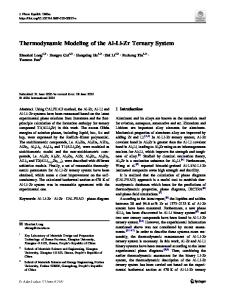Thermodynamic Modeling of the Al-Cr-Mn Ternary System
- PDF / 4,172,918 Bytes
- 19 Pages / 593.972 x 792 pts Page_size
- 32 Downloads / 349 Views
NTRODUCTION
ALUMINUM alloy is commonly used as an extrusion material for structural applications in automotive and aerospace industries. The extrusion behavior of Al alloy is related to its composition and a series of microstructural evolutions throughout the whole chain of material processing from casting, homogenization, to extrusion. The final mechanical properties of Al alloy are also highly dependent on the chemistry and microstructure. Thus, it is necessary to study the relationship between alloy composition, microstructure, extrudability, and mechanical properties. It is known that Mn and/or Cr are added into Al alloys as dispersoid formers.[1] Different types of precipitates containing Mn- and/or Cr-like Al11(Mn, Cr)4, Al6(Mn, Cr), and Al7(Cr, Mn)[2] can form during high-temperature annealing, which have limited direct effect on the mechanical properties. However, these phases have strong influence on the recovery, recrystallization, and grain growth processes, and therefore they are normally used for grain refinement. The formation of different types of Mn- and Cr-containing dispersoid is governed by the relative thermodynamic stability of each phase and the diffusion kinetics of elements behind. As a fundamental part, it is necessary to study the thermodynamic properties of Al alloys. Therefore, accurate thermodynamic information of alloy is the key fundamental knowledge for alloy design and its process optimization. As part of a large research program to develop new high-strength Al alloy for automotive SENLIN CUI and IN-HO JUNG are with the Department of Mining and Materials Engineering, McGill University, 3610 University Street, Montreal, Quebec, H3A 0C5, Canada. Contact e-mail: [email protected] Manuscript submitted August 1, 2016. Article published online January 6, 2017 METALLURGICAL AND MATERIALS TRANSACTIONS A
application, we are developing a comprehensive new Al alloy database especially focusing on the inclusion of Cr in conventional Al alloy chemistry. In the present study, the thermodynamic modeling results of the Al-Cr-Mn system are presented. There are three binary subsystems in the Al-Cr-Mn system. The thermodynamic descriptions of the three binary subsystems are the requisite for the thermodynamic modeling of the Al-Cr-Mn system. Thermodynamic modeling of the Al-Mn system was previously carried out by Jansson,[3] Liu et al.,[4] and Du et al.[5] using Bragg–Williams random mixing model for the liquid phase and by Shukla and Pelton[6] and AsgarKhan and Medraj[7] using the Modified Quasi-chemical Model (MQM) for the liquid phase. Recently, Kim and Kang[8] revised the thermodynamic description of the Al-Mn binary obtained by Du et al.[5] using MQM for the liquid phase. However, the thermodynamic description of the c_H (Al8Mn5) phase was not included. The crystal structure of the c_H phase was recently reported by Grushko et al.[9] to be the same as that of (Al8Cr5) in the Al-Cr binary system and forms a continuous solid solution at high temperature. In order to model this new feature, it is necessa
Data Loading...











